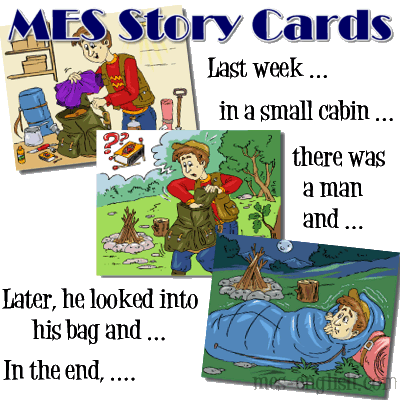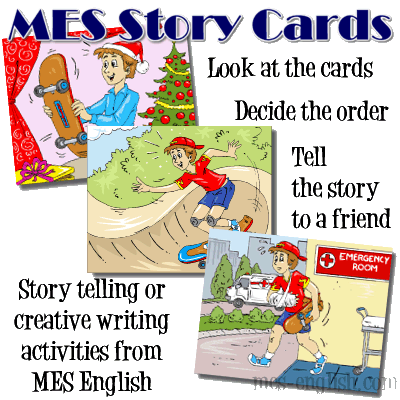

MES English Story Cards: these are stories depicted in 3 scenes to practice story telling or creative writing. For each story, there are 3 cards or events. The students look at the cards, decide the order, and tell the story (or write out the story) based on their level and what you'd like them to practice.
There are simple stories that are straight forward and some more difficult stories that require more thought and imagination to connect the events.
How to use the cards:
When? Where? What? What happened?: I start here for basic story telling and explain these 3 points as the fundamentals of story telling.
First, when and/or where did this story take place? Yesterday, last week, one day, last Christmas, once upon a time ... in a small house, in the kitchen, at the park ...
Second, what/who is there in this scene? There was a boy. His name was Tom. He liked ...
Third, what happened or was happening in the scene? He got a skateboard for Christmas.
For more advanced story telling:

Once the students have the basic story telling skills down, I try to get them to work on better descriptions using adjectives, add the feelings of the characters, and sequencing the events with adverbs.
Using More Adjectives: After the students create the base story, I point out some of the nouns in the story and ask the students to tell me more about these. 'Is it big, pretty, quiet, nice, dirty, wonderful, ...?' Then, I have the students retell part of the story (one scene/card) using more adjectives.
Desribing Feelings: Using the students base story, I ask them how the character felt after each event. 'Was he happy, sad, excited, worried, shocked, surprised ...?' Then, once we've decided how the character felt, I have the students retell part of the story, and add in the character's emotions.
Sequencing Adverbs: I start students with 'first, second, lastly' as well as 'then, next, after that'. Once they are used to sequencing their story, I teach more options: 'later that day', 'the next day', 'one week later', 'after a while', 'finally', 'in the end', and so on.
Why: Taking the student's base story, I ask them about what happened and 'why did the character do that?' and we add those answers to the story with 'because ...'.
It's not a speech!
When you are telling a story, it's not a speech. With older students, I use these cards to practice conversation strategies. I emphasize that both roles are important and we want the speaker and listener to be involved. I practice these strategies in this order:
Conversation Strategies
- responding
- follow-up questions
- getting a response
- summarizing
Responding: the speaker needs to learn to pause and let the listener respond to what was said. It shows the speaker that we are listening and that we understood what they said. The listener uses language like: 'Oh, I see.', 'Oh, really?', 'Wow!', 'Oh, no!'. I go over one or two phrases for different types of news: happy, sad/bad, surprising, interesting, funny.
Follow-up Questions: Students shoukld always respond first. It will give the listener a second or two to think about what they might ask. After responding, I explain to the students that it's important to ask a question and get more details. It shows we are interested in what the speaker is saying. So here, we need our wh- questions: what, where, why, how many and so on.
Getting a Response: If the listener is quiet or if the speaker is worried that the listener might not understand, we want to check with the listener. When the speaker pauses, if there is no response, we can use language like: 'Do you know what I mean?', 'Do you know what I'm saying?' or simply 'Ya know?'
Summarizing: When the listener is asking for a response, it's good to repeat back a short summary of what was said. 'I see. He was packing his bag for the camping trip the next day.'
There are more strategies (giving opinions, agreement/disagreement, clarification) but this should give you a good startat more advanced story telling.
I teach a conversation strategies course at university and use the same materials in my private classes with high school students and adults. If people are interested in these, I'll post those worksheets. Let me know.

MES English Certificate Templates Printable Cards Phonics Worksheets Worksheet Makers ESL Listening
End User License Agreement: You are free to download any resource from this site as an end user and MES-English.com grants you an End User License with the following restrictions: You may not redistribute, copy, modify, transfer, transmit, repackage, charge for or sell any of the materials from this site. You may use photocopies or printouts for distribution to your students. MES reserves the right to terminate or make changes to this agreement for any reason and without notice.
Copyright © 2005 - 2025 MES English | restrictions | privacy | about | contact
